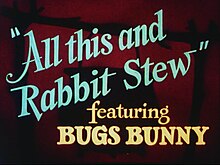|
All This and Rabbit Stew
All This and Rabbit Stew is a 1941 Merrie Melodies cartoon directed by Tex Avery.[1] The cartoon was released on September 13, 1941, and features Bugs Bunny.[2] Because of the cartoon's racial stereotypes of African-Americans, United Artists decided to withhold it from television syndication in the United States beginning in 1968. As such, the short was placed into the so-called Censored Eleven, a group of eleven Merrie Melodies and Looney Tunes shorts withheld from U.S. television distribution.[3] It was one of 12 cartoons to be pulled from Cartoon Network's 2001 "June Bugs" marathon by order of AOL Time Warner, on grounds of the subject material's offensiveness.[4] Mel Blanc and Darrell Payne were not credited for their voice work.[5] PlotAn African American hunter tries to catch Bugs Bunny, who tricks him into destroying a tree. Bugs outsmarts the hunter by using his own gun against him and tickling him. Then, Bugs leads the hunter into a cave where they encounter a bear. They both run away scared when they realize the bear is in the rabbit hole. The hunter chases Bugs with birdshot bullets, leading to a wild chase through various holes. Bugs tricks the hunter into falling off a cliff and then play the dice game craps.[6][7] Bugs wins everything the hunter has and walks away wearing the clothes of the hunter, who is left naked and embarrassed. AnalysisThe film contains a reference to World War II, when the hunter threatens to Blitzkrieg Bugs.[8] The hunter is identified in his model sheet as "Tex's Coon".[9] The hunter fills the role usually associated with Elmer Fudd; this was one of four Bugs Bunny short films of 1941 that have him facing a different hunter each time (the others were Hiawatha's Rabbit Hunt, in which Bugs faced an Indian; The Heckling Hare, in which Bugs faces Willoughby the Dog; and Wabbit Twouble, which pits Bugs against Fudd).[8] A later scholar, John Stausbauch, described the hunter in terms of racial stereotype: as a "shufflin', big lipped, sleepy-eyed country coon", who cannot resist a game of craps.[7] The hunter is dressed in a hat, a short-sleeved shirt, overalls and oversized shoes. A character with the same attire and demeanor would later be used in Angel Puss (1944). He essentially plays a stereotypical Sambo role in the film, and was named Sambo in its publicity material,[10] as he had been in Rabbit Stew. The giant hollow log gag was reused in The Big Snooze (1946), Foxy by Proxy (1952), and Person to Bunny (1960). ReceptionMotion Picture Herald (September 13, 1941): "The little colored Sambo decides to try his hand at capturing Bugs Bunny, but meets with the same success as his predecessors. Just as he has the screwy rabbit cornered, Bugs Bunny entices him into a craps game, and little Sambo winds up a sadder and wiser hunter."[6] Boxoffice (September 14, 1941): "One big, long hand. That's what this Technicolor cartoon is. It shows unmistakable signs of extra effort, preparation and ingenuity in all departments. The central character, a little bitty colored Sambo, is a cinch to capture fun-loving audiences. Here he decides to go gunning for some rabbits. He meets up with a nimble-witted adversary that has little Sambo in a constant dither."[6] Motion Picture Exhibitor (September 17, 1941): "Sambo, a little negro boy, goes rabbit hunting, meets cynical Bugs Bunny, the screwy rabbit... This is a very funny reel in every respect—characters, situations, and story. If the feature is heavy or not so good, this will make the customers feel good anyhow."[6] The Film Daily (September 12, 1941): "A Bugs Bunny Howl: Having eluded Hiawatha and other Leon Schlesinger characters, Bugs Bunny this time is pursued by Sambo in a riotous short that will make anyone laugh, and laugh hard. Trying to describe the action would be like trying to explain a maise but the Technicolor cartoon is about as mirth provoking as anything has any right to be."[11] Home media
Notes
See alsoCitation
Further reading
References
External links
|
||||||||||||||||||||||||||||
